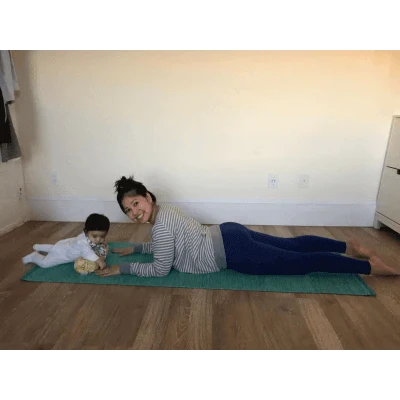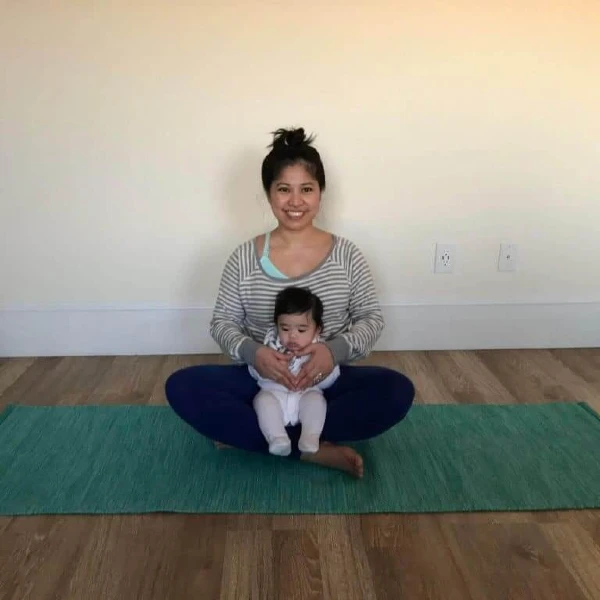What Is Prenatal Yoga?
Yoga, by definition, is a practice that aims to achieve liberation by synchronizing the mind, body, and spirit. The yoga that is practiced in the West is but a small portion of a whole with prenatal yoga being a tiny branch of that. It aims to promote a healthier mind and body and is designed to accommodate the changing physical and mental form of a woman during pregnancy.
The poses you will encounter during a prenatal yoga session are simple. Some are designed to keep your physical form fit and flexible, while some can help you ease and relax your mind and spirit.
What Yoga Poses Can I Do While Pregnant?
There is a wide variety of yoga poses out there that are made for different aspects of our bodies. You’ll be delighted to know that there are quite a few that can help you get into shape while you’re rocking that baby belly.
A study at Harvard University in 2015 tested 26 poses in 25 pregnant women and found them all safe for both the moms-to-be and their babies. This suggests that prenatal yoga is an activity that can help expectant moms to not only stay active but also maintain good mental health.
That’s right! Prenatal yoga has more than just physical advantages, it is also known to reduce stress, anxiety, and even depression especially when you start doing it in the early stages of your pregnancy.
You don’t necessarily need to enroll in a prenatal yoga class to do this, but it is advisable to always check with your healthcare professional first before starting out with any physical exercise so they can properly assess your body’s ability during these activities.
Here Are Some Poses We Suggest:
1. Easy Pose (Sukhasana)
The Easy Pose is true to its name, as the only thing you need to do is sit with your legs crossed, place your hands on your knees, and breathe. Inhale for five counts and exhale for another five. This practice of counted breathing in a relaxed position is called pranayama and is very good for calming and relaxing. Keep your eyes closed and try to melt away the bad energy you’ve been having because your favorite jeans just won’t fit anymore.
2. Wide Child’s Pose (Balasana)
As your belly starts to protrude even more, your body’s center of gravity changes. When that happens, you’ll experience difficulty in keeping your balance. You may also feel some occasional pain on your hips, thighs, and ankles. Luckily, this modified balasana pose can help remove the tension in those areas.
3. Cat-Cow Stretch (Chakravakasana)
For moments when you’re experiencing unbearable pain in your back because you’re suddenly blowing like a balloon in a short span of time, the cat-cow stretch is a perfect prenatal yoga position that will save you from tears. It’s a two-part yoga combination where you have to get down on hands and feet, drop your belly, lift your tailbone, looking forward (cow pose), then round your spine, look at your navel to create a space between your shoulder blades (cat pose). Breathe in on cow pose, then breathe out with cat pose.
4. Leg up Wall Pose (Viparita Karani)
This is another prenatal yoga pose you can do when you want to relieve those swollen feet, ankles, and legs. The leg up wall pose or Viparita Karani is easy to do as it only requires you to lie down next to a wall, swing your legs up, and then scoot your bum as close to the wall as possible with your hands resting on each side. Relax and breathe deeply while you contemplate on whether or not it’s a good idea to scarf on that jar of pickles that’s been lying around in the pantry for ages.
5. Bound Angle Pose (Baddha Konasana)
Pregnancy can pose some regular pain, especially in the lower back as your baby bump grows over time. After a series of strengthening postures, it is best to follow it up with a good pose for relieving back pain and opening the hips. The Baddha Konasana is a good way to relax your back muscles and open your hip and groin area in preparation for your delivery, but if you’re new, it would be best to do it with guidance from your prenatal yoga teacher. Remember to listen to your body. If you start to feel any pain, stop. Since posture focuses on opening the groin area and doing a little bit of stretch on the knee, if you’re injured in those parts, it would be best to avoid doing this particular pose.
6. Corpse Pose (Shavasana)
Finally, a good exercise of the mind and body wouldn’t be complete without a finishing pose. The Corpse Pose or Shavasana is quite literal in its sense, except for the fact that, of course, you will need to breathe. It’s as simple as lying down comfortably, perhaps with a bolster, blanket, or pillow on your lower back or knees for added comfort, and breathing slowly and deeply as you feel your entire body relax. The corpse pose may also be done at the beginning of a yoga class or in the middle, whenever you feel like you need to take a rest.
What Are the Benefits of Yoga During Pregnancy?
Getting excited about the latest health trends and fads is not a bad idea, although it would be best to find out about the risks and benefits related to those activities. In terms of prenatal yoga, multiple studies have proven the many benefits that an expecting mom like you can get from practicing yoga, even if you’ve just started doing it in your early stages of pregnancy.

Here Are Some of the Benefits You Can Get With Prenatal Yoga Exercises:
Improves Sleep
An experimental pilot study found that the participating women who started yoga in their 2nd trimester had fewer awakenings, reduced wake time during the night, and lesser sleep disturbance than those whose participation started in the 3rd trimester. It’s a promising study that still needs to be pursued further, but this also shows that prenatal yoga does have significant benefits for getting more Zs at night.
Reduces Stress, Anxiety, And Depression
Women practicing yoga during pregnancy were found to have lower cortisol levels than those who didn’t. It was also found that babies born to yogini mothers had better weight than those who didn’t. A double win for you and baby bump!
A 2015 review found that pregnant women who practiced prenatal yoga had a significant decrease in depression levels. However, it stated that it only works if their physical poses included meditation, deep relaxation, or breathing exercises.
Because prenatal yoga includes meditation, breathing exercises, and stretches specific to pregnant women, yogini moms are found to have better mental health than those who aren’t. This is an important fact because 14 to 23 percent of women may experience depression during and after their pregnancy, and so anything that can safely reduce the occurrence of stress, anxiety, and depression for moms-to-be is something worth considering.
Lesser Time in Labor
Prenatal yoga involves surrendering your mind and body through deep, meditative breathing. Breathing techniques allow the muscles to relax and reduce the tension during labor. It helps to minimize the pain and discomfort while waiting for your bundle of joy to come out into the world.
Helps Form a Support Group
While there may be a whole bunch of information online, nothing beats the bond you will have with women who are in the same boat as you. People are meant to interact with one another, and by sticking to those who have first-hand experience with parenting, it can be a rewarding encounter to just talk it out with people who understand what you’re going through.
Preparing for the arrival of your baby can be stressful and scary at the same time, especially for first-time moms. It sounds cliche, but the fact is that nobody was born ready to be a parent. If you have never had a child before, then the next best thing is to team up with a group of people who have “been there and done that”. Signing up for prenatal yoga classes is the easiest way to find like-minded people who can help answer your parenting questions and release the anxiety you may have about your situation.
Is Yoga Safe for Me?
Yoga is known to be an ancient method of holistic healing, involving not only the body but also the mind and soul. It has evolved throughout the ages and has branched out to many different forms used for different purposes. Yoga in itself is safe for the most part, but there are some factors that might pose a risk for you and your baby.
To minimize that risk, consider enrolling in a class that is designed specifically for pregnant women. There, an especially trained prenatal yoga teacher will guide and support you while performing the poses in complete safety.
In addition to choosing the right class, it is also best to always keep yourself hydrated. Try not to push yourself too hard. It is no competition after all. If you can’t speak properly while doing a pose, then you may need to switch to something easier.
Most importantly, make sure to ask your healthcare provider first before doing any prenatal yoga exercises. Your body will be subjected to constant stretching and movement during exercise while at the same time adapting to the rapid changes going on inside you, so consider the risks and prioritize your safety.
Can I Practice Yoga at Home?
The simple answer is yes. Though many poses may require some assistance, most of those are safe to do at home. The key to a good, safe prenatal yoga exercise is to listen to what your body tells you. Did you hear something snap or crunch? Do you feel your muscles are stretching too far? Are you out of breath? Those are some of the things you need to watch out for. Also, make sure to have a towel, bolster, or small pillow nearby. Keep them close so you can put them under your knees or lower back for comfort and support.
When to Consult a Physician?
Always check with your doctor before trying any physical exercise. Every person’s body is different. What may work for one may not work for you. So while it seems easy for that preggy teacher you saw on YouTube to do a perfect Mountain Pose, your overall health may not permit you to do the same.
If you’re feeling any pain, swelling, or inflammation in any part of your body during a prenatal yoga session or if you are bleeding somewhere or feel nauseated, it’s best to seek immediate medical help.
If you’re feeling any pain, swelling, or inflammation in any part of your body during a prenatal yoga session or if you are bleeding somewhere or feel nauseated, it’s best to seek immediate medical help.
Prenatal yoga should make your body feel good, strong, and rejuvenated. So if you’re not enjoying the poses, stop and recalibrate your body. Trust what it tells you and you’re off to a good, fulfilling mommy and mommy tummy workout.





